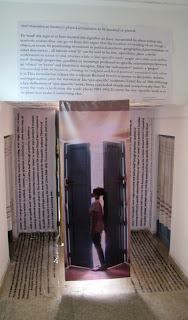stage 1:
To select text according to my practice.
so , i selected:
Excerpt
from
Site
Specific Art
Performance,space
and documentation
By
Nick Keya
"
site’:
substantive
. [. . .] local position [. . .] The
place or position
occupied by some specified thing.
Frequently implying original
or fixed position.
‘site’:
1. transitive. To locate, to place.
2.intransitive. To be
situated or placed.
To ‘read’ the sign is to have
located the signifier, to have recognised its
place within the semiotic system.
One can go on from this to argue
that the location, in reading, of an
image, object, or event, its
positioning in relation to
political, aesthetic, geographical,
institutional, or other discourses,
all inform what ‘it’ can be said
to be.Site-specificity, then, can be
understood in terms of this process,
while a ‘site-specific work’ might
articulate and define itself through
properties, qualities or meanings
produced in specific relationships
between an ‘object’ or ‘event’ and a
position it occupies. After the
‘substantive’ notion of site, such
site-specific work might even assert
a ‘proper’ relationship with its
location, claiming an ‘original and
fixed position’ associated with what
it
is. This formulation echo esthe
sculptor Richard Serra’s response to the public debate, and legal action, over
the removal of his ‘site-specific’ sculpture Tilted Arc of1981. Offering a key
definition of ‘site-specific’ work, Serraconcluded simply and unequivocally
that ‘To move the work is todestroy the work’ (Serra 1994: 194). To move the
site-specific work is to re-place it, to make it something else. "
.
Stage 2 and 3:
selection of space in the architectural site and reading performance :
Stage 4:
using drawing as a method to activate that space with the text and performance.
this is the layout of the text on the space
I adopted the process of cutting as drawing, drew my silhouette out of the paper and placed on the position where I performed on the site.
Stage 5:
Final display where we had to use the method of flex printing to document our performance an text:
viewers interaction with the work
















